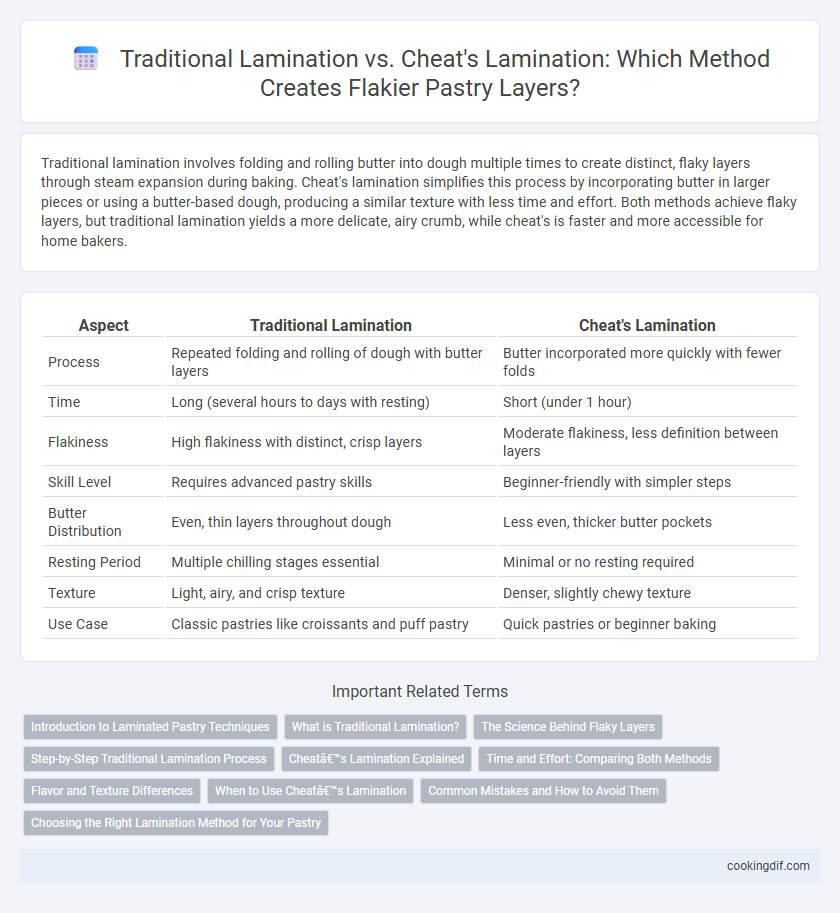Traditional lamination involves folding and rolling butter into dough multiple times to create distinct, flaky layers through steam expansion during baking. Cheat's lamination simplifies this process by incorporating butter in larger pieces or using a butter-based dough, producing a similar texture with less time and effort. Both methods achieve flaky layers, but traditional lamination yields a more delicate, airy crumb, while cheat's is faster and more accessible for home bakers.
Table of Comparison
| Aspect | Traditional Lamination | Cheat's Lamination |
|---|---|---|
| Process | Repeated folding and rolling of dough with butter layers | Butter incorporated more quickly with fewer folds |
| Time | Long (several hours to days with resting) | Short (under 1 hour) |
| Flakiness | High flakiness with distinct, crisp layers | Moderate flakiness, less definition between layers |
| Skill Level | Requires advanced pastry skills | Beginner-friendly with simpler steps |
| Butter Distribution | Even, thin layers throughout dough | Less even, thicker butter pockets |
| Resting Period | Multiple chilling stages essential | Minimal or no resting required |
| Texture | Light, airy, and crisp texture | Denser, slightly chewy texture |
| Use Case | Classic pastries like croissants and puff pastry | Quick pastries or beginner baking |
Introduction to Laminated Pastry Techniques
Traditional lamination involves folding butter into dough multiple times to create hundreds of thin, distinct layers essential for flaky pastries like croissants. Cheat's lamination shortcuts this process by incorporating butter in a simplified manner or using pre-made butter sheets, reducing preparation time while still achieving layered textures. Mastery of both techniques enhances pastry chefs' versatility in producing flaky, buttery baked goods efficiently.
What is Traditional Lamination?
Traditional lamination is a meticulous pastry technique involving repeated folding and rolling of dough with layers of butter to create multiple thin, flaky layers. This process typically requires precise temperature control and several stages of resting to ensure the butter stays cold and does not melt into the dough. The result is a delicate, airy texture characteristic of classic croissants and puff pastries.
The Science Behind Flaky Layers
Traditional lamination involves multiple folds and turns of dough and butter, creating hundreds of alternating layers that trap steam during baking, causing the dough to rise and develop distinct, flaky layers. Cheat's lamination simplifies this process by incorporating butter directly into the dough or folding it fewer times, resulting in less-defined oily layers but still achieving some flakiness through a combination of fat distribution and steam generation. The science behind flaky layers relies on controlling butter temperature and dough hydration to optimize steam production and gluten relaxation, which together form the characteristic lift and texture in laminated pastries.
Step-by-Step Traditional Lamination Process
Traditional lamination involves a meticulous step-by-step process of encasing butter within dough, followed by multiple folds and rolling sequences to create hundreds of alternating buttery and doughy layers. This method typically requires resting periods in refrigeration to relax gluten and maintain butter consistency, ensuring optimal flakiness and rise during baking. In contrast, cheat's lamination shortcuts these steps by incorporating pre-made butter or alternatives, sacrificing some flakiness and texture for speed and ease.
Cheat’s Lamination Explained
Cheat's lamination simplifies the traditional process by incorporating frozen butter chunks directly into the dough, eliminating extensive folding and resting. This method produces flaky layers more quickly, making it ideal for home bakers and beginners seeking efficiency without sacrificing texture. While traditional lamination relies on precise butter incorporation and multiple folds, cheat's lamination reduces preparation time while still achieving distinct, airy layers in pastries.
Time and Effort: Comparing Both Methods
Traditional lamination requires precise folding and resting times to create multiple flaky layers, demanding significant time and skilled effort to achieve perfect dough elasticity and butter distribution. Cheat's lamination reduces complexity and preparation time by incorporating butter more quickly, though it may produce fewer distinct layers and less flakiness. The time saved with cheat's method appeals to home bakers but often sacrifices the delicate texture prized in traditional laminated pastries like croissants.
Flavor and Texture Differences
Traditional lamination creates distinct, buttery layers by folding and rolling dough with cold butter multiple times, resulting in a complex, crisp texture and rich, deep flavor. Cheat's lamination uses grated or softened butter incorporated quickly into the dough, producing a less defined layering but a softer, more tender crumb with milder buttery notes. Flavor intensity and flakiness are typically superior in traditional lamination due to the even distribution and sealing of butter layers achieved through precise folding techniques.
When to Use Cheat’s Lamination
Cheat's lamination is ideal for quick pastry projects requiring flaky layers without extended resting times, making it perfect for home bakers or busy kitchens. It uses fewer folds and incorporates butter differently, reducing preparation time while still creating visible layers. This method works best when convenience and efficiency are prioritized over the ultra-flaky, delicate texture achieved by traditional lamination.
Common Mistakes and How to Avoid Them
Traditional lamination requires precise folding and chilling to create flaky layers, but common mistakes include overworking the dough and insufficient resting time, which cause tough pastry. Cheat's lamination often skips multiple folds or uses shortcuts like incorporating frozen butter chunks, risking uneven layers and greasy texture. To avoid these issues, maintain consistent dough temperature, allow adequate resting, and use proper butter distribution techniques for optimal flakiness.
Choosing the Right Lamination Method for Your Pastry
Traditional lamination involves meticulously folding butter into dough multiple times to create distinct, flaky layers, essential for pastries like croissants and puff pastry. Cheat's lamination uses simpler techniques such as incorporating butter chips or single folds to speed up the process, yielding acceptable flakiness but with less pronounced layers. Choosing the right lamination method depends on balancing desired flakiness, preparation time, and available skill level, with traditional lamination ideal for professional quality and cheat's lamination suitable for home bakers seeking quicker results.
Traditional Lamination vs Cheat’s Lamination for flaky layers Infographic

 cookingdif.com
cookingdif.com